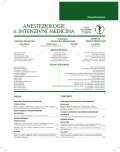Echocardiography in acute aortic syndromes
Authors:
J. Kunstýř; M. Pořízka
Authors‘ workplace:
Klinika anesteziologie, resuscitace a intenzivní medicíny, 1. lékařská fakulta Univerzity Karlovy a Všeobecná fakultní nemocnice v Praze
Published in:
Anest. intenziv. Med., 28, 2017, č. 5, s. 316-319
Category:
Overview
Acute aortic syndromes are life-threatening situation necessitating prompt and correct diagnosis. Ultrasound is the fastest available imaging method for the anaesthetists and intensivists in the intensive care units and emergency rooms. In this brief article, the authors present specifically just the basics of echocardiography in these situations while intentionally omitting other important points concerning the issue: the prevalence, classification, epidemiology, risk factors, symptoms, other imaging methods and details of treatment of acute aortic syndromes.
Keywords:
echocardiography − acute aortic syndromes − aortic dissection
Sources
1. Šťásek J, Němec P, Vítovec J, Summary of the 2014 ESC Guidelines on the diagnosis and treatment of aortic diseases: Prepared by the Czech Society of Cardiology. Cor et Vasa. 2015;57:455−476.
2. Meredith EL, Masani ND. Echocardiography in the emergency assesment of acute aortic syndromes. Eur Journ Echocardiography. 2009;10:i31−i39.
3. Nienaber CA. The role of imaging in acute aortic syndrome. Eur Heart Journ. 2013;14:15−23.
4. Pape LA, Awais M, Woznicki EM, Suzuki T, Trimarchi S, Evangelista A, Myrmel T, Larsen M, Harris KM, Greason K, Di Eusanio M, Bossone E, Montgomery DG, Eagle KA, Nienaber CA, Isselbacher EM, O'Gara P. Presentation, Diagnosis, and Outcomes of Acute Aortic Dissection: 17- Year Trends From the International Registry of Acute Aortic Dissection. J Am Coll Cardiol. 2015;66:350−8.
5. Eichelberger JP. Aortic dissection without intimal tear: case report and findings on transesophageal echocardiography. J Am Soc Echocard. 1994;7:82−6.
6. Coady M, Rizzo J, Elefteriades J. Pathologic variants of thoracic aortic dissections. Penetrating atherosclerotic ulcers and intramural hematomas. Cardiol Clin North Am. 1999;17:637−57.
7. Robbins R, McManus R, Mitchell R, Latter D, Moon M, Olinger G, Miller DC. Management of patients with intramural hematoma of the thoracic aorta. Circulation. 1993;88:1−10.
8. Kitai T, Kaji S, Yamamuro A, Tani T, Kinoshita M, Ehara N, Kobori A, Kim K, Kita T, Furukawa Y. Detection of intimal defect by 64-row multidetector computed tomography in patients with acute aortic intramural hematoma. Circulation. 2011;124:S174−8.
9. Nathan DP, Boonn W, Lai E, Wang GJ, Desai N, Woo EY, Fairman RM, Jackson BM. Presentation, complications, and natural history of penetrating atherosclerotic ulcer disease. J Vasc Surg. 2012;55:10−5.
10. Willens HJ, Kessler KM. Transesophageal echocardiography in the diagnosis of diseases of the thoracic aorta: part II-atherosclerotic and traumatic diseases of the aorta. Chest. 2000;117:233−243.
Labels
Anaesthesiology, Resuscitation and Inten Intensive Care Medicine Trauma surgery Pain managementArticle was published in
Anaesthesiology and Intensive Care Medicine

2017 Issue 5
Most read in this issue
- Succesful use of methylene blue in a patient with refractory shock on veno-arterial extracorporeal membrane oxygenation
- Cognitive disorders in perioperative and intensive care
- Neurotoxicity of anaesthetics on the developing brain
- The endothelial glycocalyx and fluid therapy in critical care and perioperative medicine
